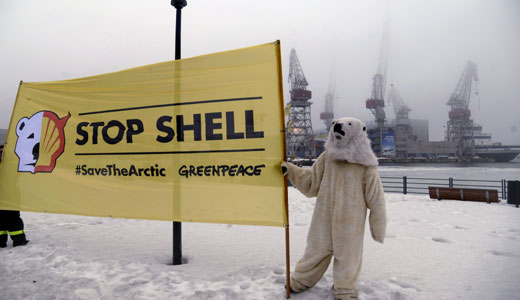
Ignoring the collective outrage of environmental groups, oil giant Shell began drilling into the Arctic on September 9, boring holes 1,400 feet beneath the Chukchi Sea’s floor. A day later, drilling had stopped – and remains so, temporarily – due to sea ice moving into and obstructing the area. Meanwhile, activists continue to protest as Shell plans to commence drilling in the Beaufort Sea in a few weeks’ time.
The oil company moved forward with its drilling plans after passing a “safety test” that environmentalists have criticized, including watchdog group Public Employees for Environmental Responsibility, which acquired Shell’s testing results through a Freedom of Information Act request. They concluded that the results failed to live up to the “comprehensive testing” to “meet rigorous new standards” of which the corporation had spoken.
“The first test merely showed that Shell could dangle its cap in 200 feet of water without dropping it,” said PEER staff counsel Kathryn Douglass. “The second showed that the capping system could hold up under laboratory conditions for 15 minutes without crumpling. Neither result should give the American public much comfort.”
When Shell announced it was moving off the well in the Chukchi Sea due to encroaching sea ice, the news came as a brief period of reprieve for those concerned about the disastrous impacts tampering with this sensitive ecosystem could have. Shell, however, plans to resume work as soon as possible.
Ben Ayliffe, senior Arctic campaigner at Greenpeace, called the company’s limited testing “reckless,” and voiced his hope that the drilling could still be stopped with enough collective action.
“The only option now,” he said, “is for the U.S. government to call a halt to Shell’s plans to open up the frozen north, because the company is so clearly unable to operate safely in the planet’s most extreme environment.”
To add to concerns, Shell will be allowed to drill in non-hydrocarbon zones without its oil spill containment barge – the Arctic Challenger – present.
That, said Alaska Wilderness League executive director Cindy Shogan, is a dangerous move. “There is equipment on the Arctic Challenger that could be crucial in the case of an accident such as a gas blowout – something that is known to happen in non-hydrocarbon drilling – and is designed to accomodate the Arctic’s extreme conditions,” she remarked.
And yet, the Arctic Challenger currently remains inactive in Bellingham, Washington.
Shell and other oil companies have seen fit to capitalize on a key problem currently occurring in the Arctic – melting sea ice, which opens up the waters to oil exploration. The vanishing ice is a direct result of climate change, and though Shell apparently sought to utilize that as a window for drilling, the project has nevertheless been delayed now – at least in the Chukchi Sea.
That is but a small comfort, however, for environmental activists who gathered at an entrance to the company’s London headquarters on September 11, blockading it with a giant pyramid of ice blocks. The protesters, part of a group called the Climate Justice Collective, were directly demonstrating against Shell’s meddling in the Arctic.
A protester named Lucy, who did not want to give her surname, remarked, “Something needs to be done right now. Shell is responsible for drilling in the Arctic sea. They are drilling in a new area. This must stop, and Shell must be held [accountable]. This is an unprecedented disaster that we are trying to minimize.”
The U.K. nonprofit organization is not the first to head directly to Shell’s HQ to make their voices heard. Less than two months ago, Greenpeace activists came there to protest – and also sabotaged 71 gas stations across London, declaring it was time to “draw a line in the ice and tell Shell to stop.”
Once the obstructing ice has passed, Shell is expecting to continue its activity in the Chukchi Sea. However, the company is required to cease drilling by Sept. 24, to allow time for a relief well to be drilled if necessary, before winter ice sets in. But Shell is asking for an extension on that deadline.
Ayliffe said, “Whatever Shell is able to do between now and when the sea ice returns, it won’t erase the clear evidence we’ve seen that there’s no such thing as safe drilling in the Arctic.”
Photo: Activists with Greenpeace protest Shell’s tampering in the Arctic. Markku Ulander/AP & Lehtikuva












Comments